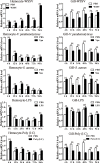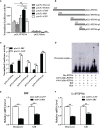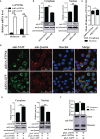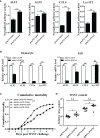The Non-Receptor Protein Tyrosine Phosphatase PTPN6 Mediates a Positive Regulatory Approach From the Interferon Regulatory Factor to the JAK/STAT Pathway in Litopenaeus vannamei
- PMID: 35844582
- PMCID: PMC9276969
- DOI: 10.3389/fimmu.2022.913955
The Non-Receptor Protein Tyrosine Phosphatase PTPN6 Mediates a Positive Regulatory Approach From the Interferon Regulatory Factor to the JAK/STAT Pathway in Litopenaeus vannamei
Abstract
SH2-domain-containing protein tyrosine phosphatases (PTPs), belonging to the class I PTP superfamily, are responsible for the dephosphorylation on the phosphorylated tyrosine residues in some proteins that are involved in multiple biological processes in eukaryotes. The Janus kinase/signal transducers and activators of transcription (JAK/STAT) pathway transduce signaling responding to interferons and initiate cellular antiviral responses. The activity of the JAK/STAT pathway is generally orchestrated by the de-/phosphorylation of the tyrosine and serine residues of JAKs and STATs, in which the dephosphorylation processes are mainly controlled by PTPs. In the present study, an SH2-domian-contianing PTP, temporally named as LvPTPN6, was identified in Litopenaeus vannamei. LvPTPN6 shares high similarity with PTPN6s from other organisms and was phylogenetically categorized into the clade of arthropods that differs from those of fishes and mammals. LvPTPN6 was constitutively expressed in all detected tissues, located mainly in the cytoplasm, and differentially induced in hemocyte and gill after the challenge of stimulants, indicating its complicated regulatory roles in shrimp immune responses. Intriguingly, the expression of LvPTPN6 was regulated by interferon regulatory factor (IRF), which could directly bind to the LvPTPN6 promoter. Surprisingly, unlike other PTPN6s, LvPTPN6 could promote the dimerization of STAT and facilitate its nuclear localization, which further elevated the expression of STAT-targeting immune effector genes and enhanced the antiviral immunity of shrimp. Therefore, this study suggests a PTPN6-mediated regulatory approach from IRF to the JAK/STAT signaling pathway in shrimp, which provides new insights into the regulatory roles of PTPs in the JAK/STAT signaling pathway and contributes to the further understanding of the mechanisms of antiviral immunity in invertebrates.
Keywords: IFN regulatory factor; JAK/STAT signaling pathway; Litopenaeus vannamei; antiviral immunity; non-receptor protein tyrosine phosphatase.
Copyright © 2022 Luo, Xu, Liu, Shen, Yang, Zhu, Weng, He and Zuo.
Conflict of interest statement
The authors declare that the research was conducted in the absence of any commercial or financial relationships that could be construed as a potential conflict of interest.
Figures








Similar articles
-
A Negative Regulatory Feedback Loop within the JAK-STAT Pathway Mediated by the Protein Tyrosine Phosphatase DUSP14 in Shrimp.J Immunol. 2024 Jul 1;213(1):63-74. doi: 10.4049/jimmunol.2300871. J Immunol. 2024. PMID: 38767414
-
A Janus Kinase in the JAK/STAT signaling pathway from Litopenaeus vannamei is involved in antiviral immune response.Fish Shellfish Immunol. 2015 Jun;44(2):662-73. doi: 10.1016/j.fsi.2015.03.031. Epub 2015 Apr 1. Fish Shellfish Immunol. 2015. PMID: 25839969
-
Immune regulation mediated by JAK/STAT signaling pathway in hemocytes of Pacific white shrimps, Litopenaeus vannamei stimulated by lipopolysaccharide.Fish Shellfish Immunol. 2022 Nov;130:141-154. doi: 10.1016/j.fsi.2022.07.048. Epub 2022 Aug 3. Fish Shellfish Immunol. 2022. PMID: 35932985
-
Protein tyrosine phosphatases in the JAK/STAT pathway.Front Biosci. 2008 May 1;13:4925-32. doi: 10.2741/3051. Front Biosci. 2008. PMID: 18508557 Free PMC article. Review.
-
TC-PTP and PTP1B: Regulating JAK-STAT signaling, controlling lymphoid malignancies.Cytokine. 2016 Jun;82:52-7. doi: 10.1016/j.cyto.2015.12.025. Epub 2016 Jan 23. Cytokine. 2016. PMID: 26817397 Review.
Cited by
-
Platelet ITGA2B inhibits caspase-8 and Rip3/Mlkl-dependent platelet death though PTPN6 during sepsis.iScience. 2023 Jul 19;26(8):107414. doi: 10.1016/j.isci.2023.107414. eCollection 2023 Aug 18. iScience. 2023. PMID: 37554440 Free PMC article.
-
Targeting the JAK-STAT pathway in colorectal cancer: mechanisms, clinical implications, and therapeutic potential.Front Cell Dev Biol. 2024 Nov 26;12:1507621. doi: 10.3389/fcell.2024.1507621. eCollection 2024. Front Cell Dev Biol. 2024. PMID: 39659524 Free PMC article. Review.
-
Mechanisms and therapeutic prospect of the JAK-STAT signaling pathway in liver cancer.Mol Cell Biochem. 2025 Jan;480(1):1-17. doi: 10.1007/s11010-024-04983-5. Epub 2024 Mar 22. Mol Cell Biochem. 2025. PMID: 38519710 Review.
-
Investigating the Potential Therapeutic Targeting of the JAK-STAT Pathway in Cerebrovascular Diseases: Opportunities and Challenges.Mol Neurobiol. 2025 Jul;62(7):9338-9364. doi: 10.1007/s12035-025-04834-4. Epub 2025 Mar 18. Mol Neurobiol. 2025. PMID: 40102347 Review.
-
Characterization of microsatellite markers in the coding regions of the Penaeus vannamei genome.PLoS One. 2024 May 2;19(5):e0289351. doi: 10.1371/journal.pone.0289351. eCollection 2024. PLoS One. 2024. PMID: 38696386 Free PMC article.
References
Publication types
MeSH terms
Substances
LinkOut - more resources
Full Text Sources

